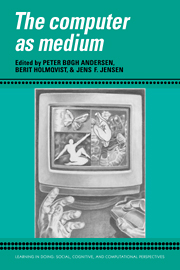Book contents
- Frontmatter
- Contents
- Series foreword
- Preface
- Contributors
- Part I Computer-based signs
- Introduction
- 1 A semiotic approach to programming
- 2 Structuralism, computation, and cognition: The contribution of glossematics
- 3 The shortest way between two points is a good idea: Signs, Peirce, and theorematic machines
- 4 Logic grammar and the triadic sign relation
- 5 Meaning and the machine: Toward a semiotics of interaction
- Part II The rhetoric of interactive media
- Part III Computers in context
- Index
1 - A semiotic approach to programming
Published online by Cambridge University Press: 05 October 2010
- Frontmatter
- Contents
- Series foreword
- Preface
- Contributors
- Part I Computer-based signs
- Introduction
- 1 A semiotic approach to programming
- 2 Structuralism, computation, and cognition: The contribution of glossematics
- 3 The shortest way between two points is a good idea: Signs, Peirce, and theorematic machines
- 4 Logic grammar and the triadic sign relation
- 5 Meaning and the machine: Toward a semiotics of interaction
- Part II The rhetoric of interactive media
- Part III Computers in context
- Index
Summary
The main aim of this chapter is to argue that semiotics can serve as a theoretical framework for programming computer systems (on semiotic approaches to systems design, see Rasmussen, 1986; Kaasbøll, 1986; Nadin, 1988; Holmqvist & Bøgh Andersen, 1991; Bøgh Andersen, 1990a; Figge, 1991; Boland, 1991; Stamper, 1992). The reason is that although computers are machines, they are not ordinary machines, assembled with bolts and screws. They are symbolic machines constructed and controlled by means of signs.
The interface of the systems is an obvious example of a computer-based sign, but underneath the interface, in the intestines of the system, we also find signs. The system itself is specified by a program text (a sign since it stands for the set of possible program executions to the programmer). The actual execution involves a compiler or interpreter that directly or indirectly controls the computer by means of the program text, and since the compiler is based on a text standing for the set of permissible program texts, a part of the compiler is a meta-sign that – in some versions – very much resembles ordinary grammar.
If we continue this descent through the different layers of the system, passing through the operating system and the assembly code down to the actual machine code, we will come across signs most of the way down.
Information
- Type
- Chapter
- Information
- The Computer as Medium , pp. 16 - 67Publisher: Cambridge University PressPrint publication year: 1994
Accessibility standard: Unknown
Why this information is here
This section outlines the accessibility features of this content - including support for screen readers, full keyboard navigation and high-contrast display options. This may not be relevant for you.Accessibility Information
- 5
- Cited by
